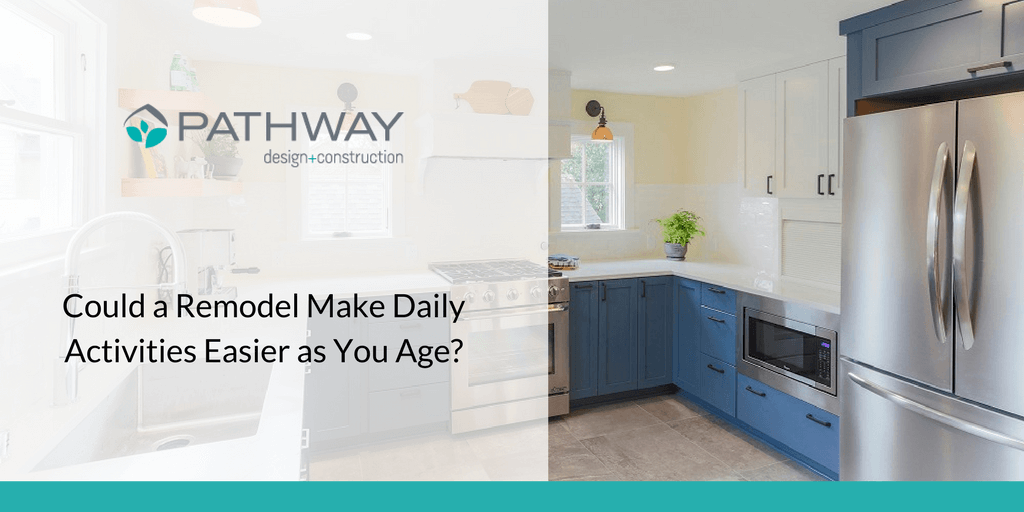There’s no place like home. This is especially true for people who have spent many years in one house – raising families and creating a rich history of memories within its walls and with the surrounding neighborhood. As we age, however, we often face mobility and health issues. What was once a comfortable and safe haven becomes a place of hazards, barriers, and challenges. But moving out of your home into an unfamiliar place to solve the problem doesn’t have to be the answer. The great news is, there are a lot of smart options for remodeling your existing home that can allow you or your loved ones to stay in the same place for years to come.
The concept I’m going to talk about is called Aging in Place (AIP). It means, simply, the ability to live in your own home safely, independently, and comfortably as you age. As a home remodeler, I have helped many clients incorporate the right modifications into their homes to age in place. It is always exciting to see the difference it makes in their lives, allowing them to age gracefully and comfortably in a place they know and love.
THE OCCUPATIONAL THERAPIST (OT)
If you’re considering wanting to stay in your home as you grow older, consider a bath or kitchen remodel. Here’s why.
Changing a home to suit your current and future needs is definitely worth a look in this competitive real estate market.
The benefits are twofold, at least.
Not only would you be able to get a more modern and manageable day-to-day design as you and your loved ones age, but you’ll also be able to stay in that home longer as well.
How?
By updating the functionality in your house to ease daily tasks, you’ll maintain your independence for a longer period of time. And stay in your beloved home for more years to come.
A third benefit? The return-on-investment (ROI) increases with bath and kitchen remodels when a home does get listed on the market, in case you choose to move.
Why kitchen or bath?
According to HealthinAging.org, “Many older people experience problems in daily living because of chronic illnesses or health-related disabilities. Those difficulties restrict their ability to perform self-care. This inability for self-care is a common reason why older people seek help from outsiders, move to assisted living communities, or enter nursing homes.”
Many of the tasks relating with self care mentioned usually take place in either the bath or kitchen. Often taken for granted, these tasks include:
Bath
- Showering or bathing
- Grooming
- Dressing
- Using the toilet (including both sitting down to it and then also getting up from it)
Kitchen
- Preparing foods with chopping or washing
- Cooking
- Eating
And of course, walking throughout the home. And then cleaning too.
Assess your own home
Take a look in your bath or kitchen and see if you can spot areas that could be more functional, and more beautiful.
One easy way to begin is with the lighting. If you’re living in a house that’s more than 40 or 50 years old (built in the 70’s or 80’s or earlier), chances are good the lighting may need some attention. This suggestion is for safety as well as for beautification. If it’s too dark or dingy in a house, some refreshed lighting is going to make a big difference right away.
But keep looking.

Too high? Too low?
In your kitchen, take a look at the cabinets…Are they too high? Is a step stool needed to get needed foods or plates or glasses?
Or, are the cabinets too low? Do you need to get down on your knees to reach back for the roasting pan or electric grill?
Updating and reworking the cabinets can make a huge difference.

Easy access to regularly needed and used ingredients and utensils will not only keep you in and managing the kitchen but also cooking real food longer as well.
Difficult to imagine now?
It may be challenging to imagine that one day putting a shirt on could be a burden, or that a lot of effort would be needed to prepare your lunch. We don’t like thinking of these scenarios.
But what if your home layout and function could help you? Ease the efforts required and allow you to keep your independence for a longer period of time?
What if you could also get suggestions and ideas about what those needed design elements would be? And get a real number in a quote?
Not everyone thinks in these terms, of remodeling a house to keep you in the home longer, but we do.
Do you have questions about aging in place or remodeling your home? We’d appreciate the privilege of being your resource and first choice remodeling contractor.
Let’s talk about your home’s bath or kitchen. We offer an initial consult meeting at the office and will share an honest and transparent look at viability and budget right off the bat.
What else?Improving accessibility will help older homeowners age in place (featured in Seattle Times)
Is ‘visitability’ included in your home remodel goals? (featured in Seattle Times)
Remodeling Toward a More “Universal Design”
Remodeling Strategies for Aging Homeowners
See a few remodels in action
Follow our projects on Houzz, or follow and watch our progressive remodel live videos on our Facebook page.
Contact us when you’re ready to discuss a remodel and aging in place.


